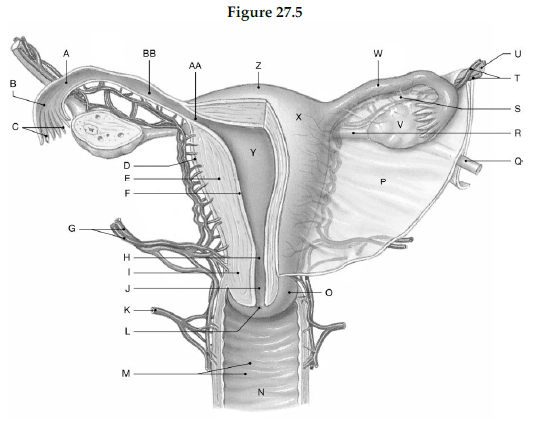Using the figure below, identify the labeled part.

1) Label A: ______________________________
2) Label B: ______________________________
3) Label C: ______________________________
4) Label D: ______________________________
5) Label E: ______________________________
6) Label F: ______________________________
7) Label G: ______________________________
8) Label H: ______________________________
9) Label I: ______________________________
10) Label J: ______________________________
11) Label K: ______________________________
12) Label L: ______________________________
13) Label M: ______________________________
14) Label N: ______________________________
15) Label O: ______________________________
16) Label P: ______________________________
17) Label Q: ______________________________
18) Label R: ______________________________
19) Label S: ______________________________
20) Label T: ______________________________
21) Label U: ______________________________
22) Label V: ______________________________
23) Label W: ______________________________
24) Label X: ______________________________
25) Label Y: ______________________________
26) Label Z: ______________________________
27) Label AA: ______________________________
28) Label BB: ______________________________
1) Ampulla
2) Infundibulum
3) Fimbriae
4) Perimetrium
5) Myometrium
6) Endometrium
7) Uterine artery and vein
8) Internal os (internal orifice
9) Isthmus of uterus
10) Cervical canal
11) Vaginal artery
12) External os (external orifice
13) Vaginal rugae
14) Vagina
15) Cervix
16) Broad ligament
17) Round ligament of uterus
18) Ovarian ligament
19) Mesovarium
20) Ovarian artery and vein
21) Suspensory ligament of ovary
22) Ovary
23) Uterine tube
24) Body of uterus
25) Uterine cavity
26) Fundus of uterus
27) Uterine part
28) Isthmus
You might also like to view...
The ________ veins drain the testes in males.
A. suprarenal B. renal C. testicular D. ovarian E. mesenteric
A white blood cell engulfs a bacterium through a process called:
A) primary active transport. B) exocytosis. C) endocytosis. D) facilitated diffusion.
Which arteries are connected to the anterior cerebral arteries by the posterior communicating arteries?
A) Posterior cerebral arteries B) Vertebral arteries C) Middle cerebral arteries D) Basilar arteries
Which event occurs last at the neuromuscular junction?
A) Neurotransmitters enter the synaptic cleft. B) Sodium channels on the motor end plate open. C) An action potential reaches the presynaptic membrane. D) Sodium enters the muscle fiber.